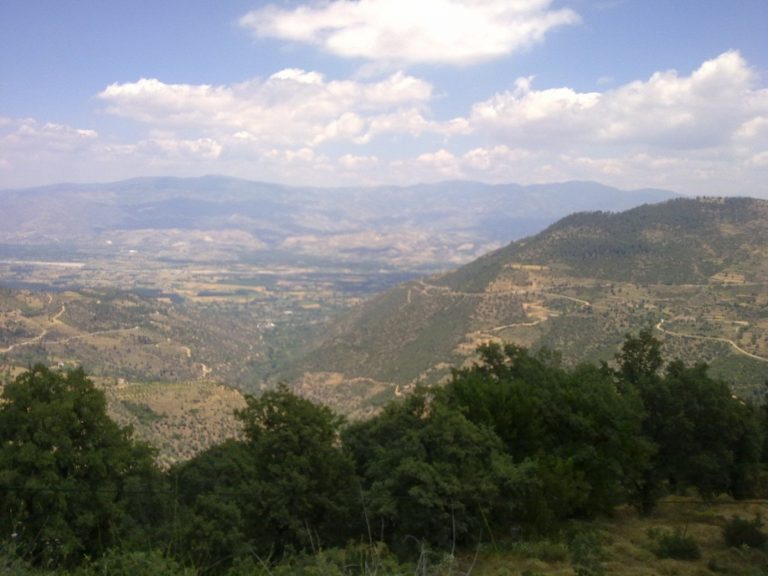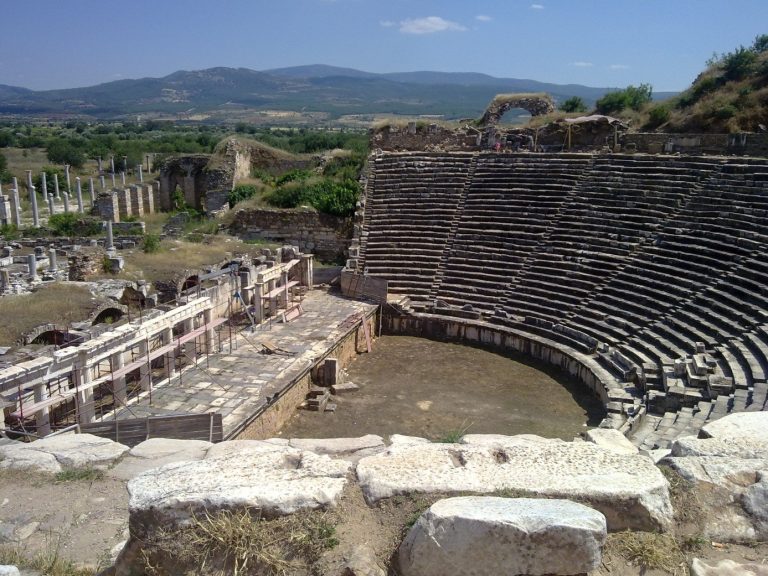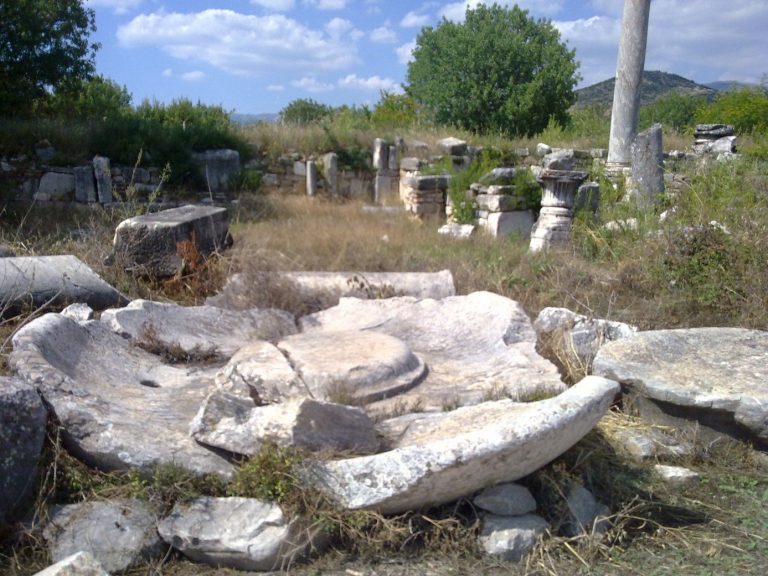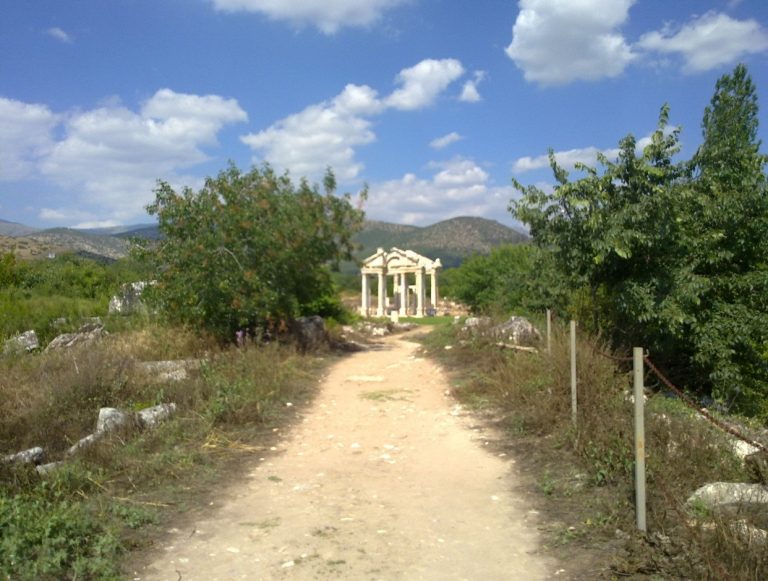Tales of Anatolia: From Hekatesia to Aphrodisias, Part 2 – July 2012
… to be continued… the journey goes on to Didyma and the Temple of Apollo and to Aphrodisias.
For an extended article about The Temple of Apollo at Didyma, modern Didim, please refer to the separate article ‘The Apollo Temple of Didyma‘.
From Bodrum to Aphrodisias is quite a long journey, not only distance-wise but also the terrain we covered by car. Climbing to heights of over 1800 meters there were some spectacular views.
The temple complex, as in many other cases such as Lagina, covers a large area often several square kilometres. I arrived at Geyre and the starting point for the temple. There was the usual market with souvenirs and local produce of textiles and pottery. I often wonder if this was also the case when pilgrims travelled to the various temples for the annual festivals many hundreds of years ago. Wasn’t I also a pilgrim?
Several of us gathered together and we were instructed to step into “the tractor” which was in fact an open wagon pulled by a tractor. After a rather bumpy ride we stepped out into shady forecourt where there was a museum shop and a large modern building housing the present museum.
More about this later. First a little background information.

Map copyright PlanetWare.com
“The ancient city of Aphrodisias, once the capital of the province of Lydia, is located near the village of Geyre in the district of Karacasu 38 km south of Nazilli. In ancient times, the attractive marble buildings of Aphrodisias no doubt shone out, as they do now, from amidst the rich vegetation of the Dandalaz valley with its almond, pomegranate and poplar trees.
The wealth and cultural and political importance of the city is clearly attested by the size and magnificence of the buildings of which it is composed. The name Aphrodisias is derived from Aphrodite, the goddess of nature, beauty, love and plenty, and was one of the most famous cult centres of the goddess. But this was not the original name of the city. According to the historian Stephanus it was founded by the Lelegians and was first known as Lelegonopolis.The name of the city was later changed to Megalopolis, and later again to Ninoe after Ninos, the King of Assyria.
The history of the city can be traced back to the early bronze age and there is even clear evidence of a chalcolithic culture prior to the 3rd millennium B.C. The use of the name Aphrodisias began after the 3rd century B.C., in the Hellenistic period.The spread of Christianity under the Byzantine Empire and the gradual adoption of Christianity as the state religion resulted in a marked change in the status of the city. The cult centre of Aphrodite declined in importance, to such an extent that the names Aphrodite and Aphrodisias were finally erased from all the inscriptions.” (1)
I have tried to find out more about the neolithic remains but apart from very brief mentions it seems that little is actually known.
“Two prehistoric settlement mounds mark the earliest habitation of the site, in the sixth or fifth millenium B.C. In spite of its long occupation, Aphrodisias remained a small village until the second century B.C., the date of the earliest coins and inscriptions recording the name of the city.”
(http://www.nyu.edu/projects/aphrodisias/hist.htm)
Of course it is precisely this earlier period which interests me the most 🙂
The statue of Aphrodisias reminded me of the statue of Artemis at Ephesus with both goddesses wearing what seems to be an elaborate gown with multiple pockets or pouches.
This is Aphrodisias:
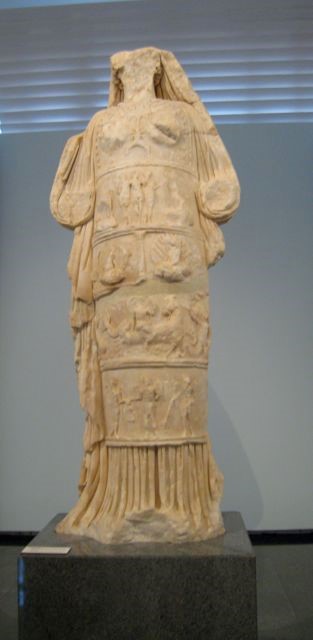
(http://allisonwucher.com/wordpress/2010/03/08/turkey-tour-day-two-aphrodisias-hierapolis-pamukkale/)
This is Artemis of Ephesus
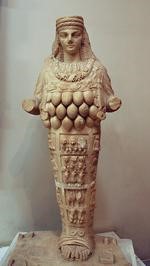 Clearly these two images of the goddesses have many similarities.
Clearly these two images of the goddesses have many similarities.
“The cult image that is particular to Aphrodisias, the Aphrodite of Aphrodisias, doubtless was once housed in the Temple of Aphrodite. She was a distinctive local goddess who became, by interpretatio graeca identified with the Greek Aphrodite. Her canonical image, typical of Anatolian cult images, shows that she is related to the Lady of Ephesus, widely venerated in the Greco-Roman world as Artemis of Ephesus. The surviving images, from contexts where they must have been more civic than ritual, are without exception from the late phase of the cult, in Hellenistic and Roman times. They are rendered in the naturalistic style common to their culture, which gave the local goddess more universal appeal. Like the Lady of Ephesus, the “Aphrodite” of Aphrodisias wears a thick, form-disguising tunic, encasing her as if in a columnar box, always with four registers of standardized imagery. Her feet are of necessity close together, her forearms stretched forward, to receive and to give. She is adorned with necklaces and wears a mural crown together with a diadem and a wreath of Myrtle, draped with a long veil that frames her face and extends to the ground. Beneath her overtunic she wears a floor-length chiton. The bands of decoration on the tunic, rendered in bas-relief, evoke the Goddess’s cosmic powers: the Charities, the Three Graces that are the closest attendants of Aphrodite; heads of a married pair (the woman is veiled), identified by Lisa Brody as Gaia and Uranos, Earth and the Heavens, over which this goddess reigns.”
http://en.wikipedia.org/wiki/Aphrodisias
Both statues reflect the goddess’s connection with the Earth and Gaia and the seasonal cycles. The pouches at Artemis’ breast look significantly like the pods bees lay their eggs into and remind us of the strict hierarchy, whilst Aphrodisias too reflects her connection with the populace, the people. I was also reminded that one of the names of Aphrodisias was in fact ‘Megalopolis’ meaning literally ‘large city’.
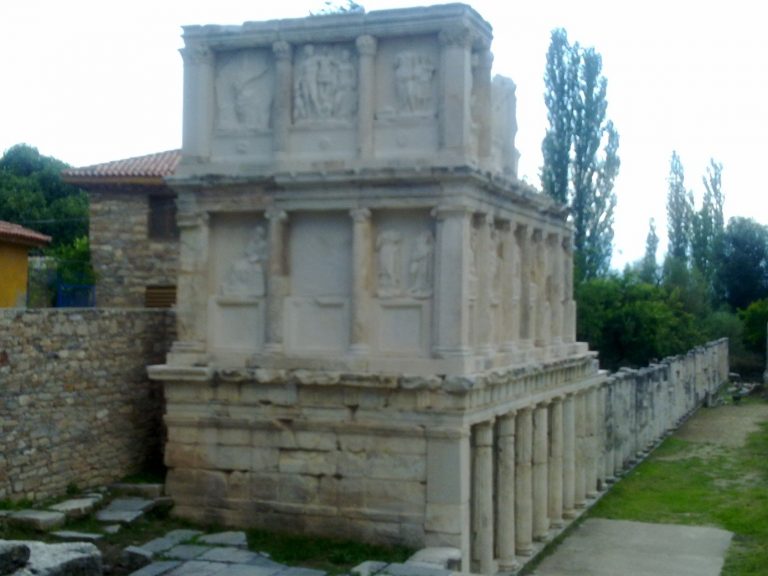
The Three Graces depicted at the Sebasteion (Morgana June 2012)
With the lush vegetation and rich fertile plains this area of Anatolia must have been extremely attractive for many different peoples.
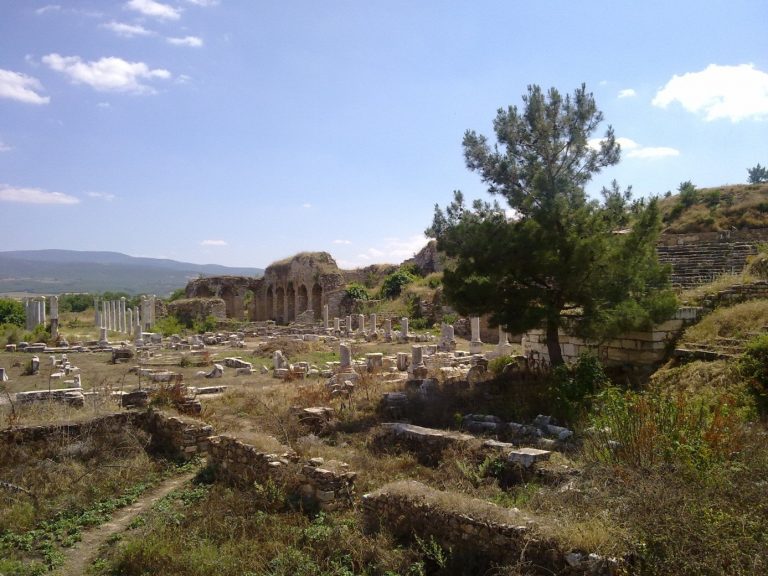
The Temple of Aphrodite (Morgana June 2012)
“Located in the northern section, in ancient times the Temple of Aphrodite formed the centre and nucleus of the city. All that remains of the ancient temple consists of fourteen of the over forty Ionic columns that once surrounded it and the foundations of the cella section. Although the cult centre dates back to earlier times the temple whose remains we see today was begun in the 1st century B.C. and is thought to have been completed during the reign of Augustus. The temenos (temple precinct) was completed in the 2nd century during the reign of Hadrian. The building would appear to have been what is known as an octastyle temple with thirteen columns on each side and eight columns at front and rear. On some of the columns are inscribed the names of the donors who presented them to the temple. The discovery of several mosaic fragments belonging to the Hellenistic period indicate the existence of an older temple on the same site, but with the conversion of the temple to a church in the 5th century all traces of the older building were erased. At the same time, the walls of the cella containing the cult statues were removed and the building enlarged by moving the side columns outwards. Walls were added at the front and rear of the building to form an apse and nave. An apse and an atrium were added on the east and west. No cult statue was found in the cella but in 1962 a statue was found immediately outside it bearing all the characteristics of a cult statue.” (2)
The Theatre (Morgana June 2012)
The Remains of an Altar. (Morgana 2012)
When I saw this altar I was immediately reminded of the oyster shell so often associated with Aphrodite. I didn’t find any evidence to support this idea and perhaps it was the way it had fallen which gave me this impression? As you can see it looks like a big dish.
There are a number of other interesting features at Aphrodisias including the
Sebastion: “The Sebastion is a most remarkable discovery, not only as regards the excavations in Aphrodisias but in the whole context of classical archaeological excavation. When the building was first unearthed in 1979 it appeared to have no relation to any other building but, as excavations were carried down to deeper levels, it became apparent that this consisted of a temple dedicated to the cult of the Emperor Augustus (Sebastos is the Greek equivalent of the Latin Augustus) and its surrounding complex.”
Baths of Hadrian: “The baths constructed in the 2nd century during the reign of the Emperor Hadrian lie to the west of the Portico of Tiberius. This complex consists of a large central hall, probably the caldarium or hot room, surrounded. by four large rooms, the tepidarium, sýýdatorium, apoditerium and frigidarium (warm room, sweating room, dressing room and cold room respectively).
It is a most imposing building with all the requisite facilities, such as labyrinthine underground service corridors, water channels and furnaces.
In the excavations conducted here in 1904 the French archaeologist Paul Gaudin unearthed a large number of artistic works now preserved in the Istanbul Archaeological Museum. (3)
Bouleuterion
The Bouleuterion (Council House) is centred on the north side of the North Agora. it consists of a semicircular auditorium fronted by a shallow stage structure about 46 m wide.
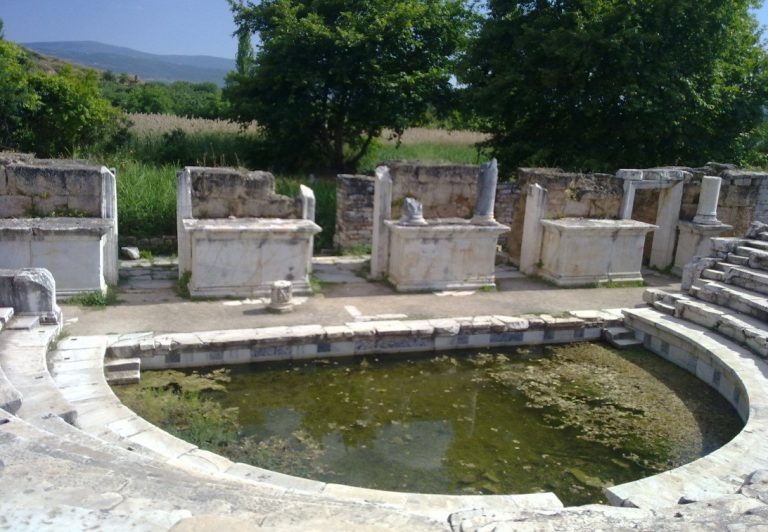
Bouleuterion from above (Morgana June 2012)
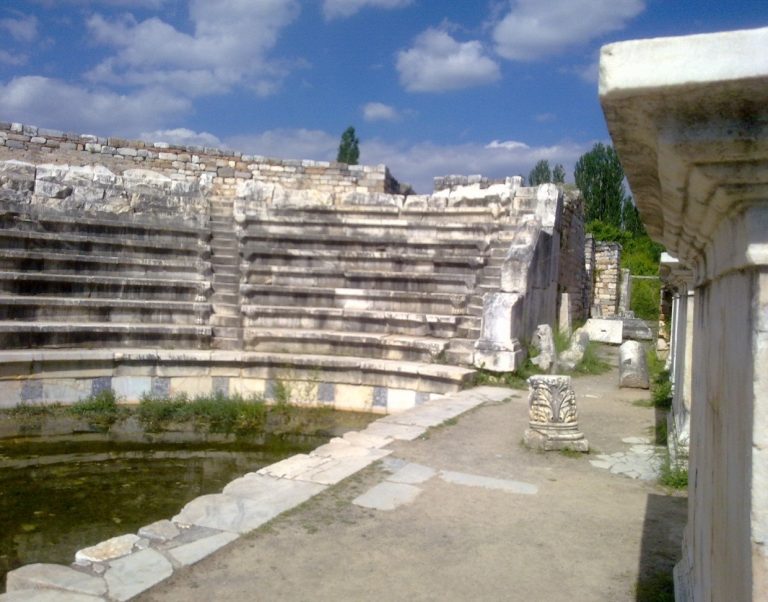
Bouleuterion from the side, looking upwards. (Morgana June 2012)
One of the most impressive sites at Aphrodisias is the Tetrapylon, or Ornamental Gate. It is called the Tetrapylon because of the four groups of columns. It has been extensively repaired and reconstructed (1990). This is the view walking from the main temple area. It is quite breath-taking!
The path to The Tetrapylon (Morgana, June 2012)
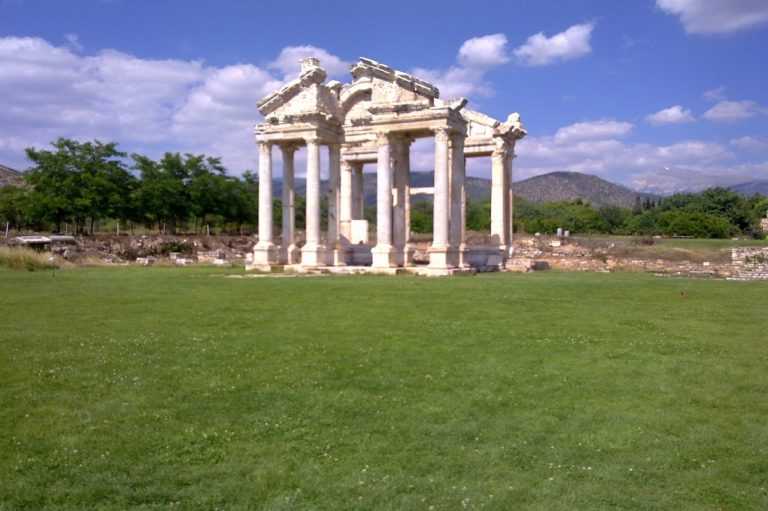
The Tetrapylon (Morgana June 2012)
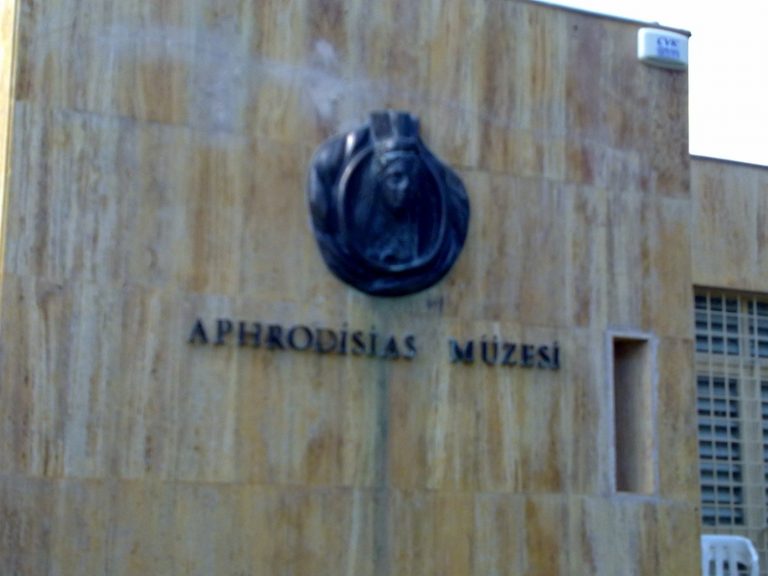
The head of Aphrodite of Aphrodisias adorns the entrance of the museum (Morgana June 2012)
The Museum:
A modern building, the museum houses some of the city’s famous marble sculptures. It also includes the cult statue of Aphrodite that stood in the temple. See description above. I was amazed at the large hall of rows of reliefs/statues.
Here is an interesting account of the discovery of Aphrodisias and the founding of the museum:
It’s September 1958. The then Prime Minister is going to open Turkey’s biggest dam, the Kemer. Getting wind of the event, Hayat (Life) magazine quickly dispatches photojournalist Ara Güler to the nearby town of Aydın. Provided with a car and driver by the governor’s office, Güler is still shooting when night falls. They lose their way, winding up in a coffeehouse in a remote mountain village. The locals are playing cards on top of a Roman column capital. As soon as it gets light the next morning, Güler takes a look around the village, photographing the reliefs of figures on sarcophagi crushing grapes and driving a pair around the Hippodrome. The village is Geyre. On his return to Istanbul he shows his pictures first to writer and culture doyen Sabahattin Eyuboğlu, and then to Rüstem Doyuran, Director of the Archaeological Museum. No one is familiar with this place. Güler has the idea of sending his photos to the Architectural Review. Not long afterwards a telegram arrives from the American journal, Horizon. Güler returns to the village with the same driver. When the journal requests a ‘very well known’ writer, Prof. PhD.. Kenan T. Erim is enlisted. And from that day forward, Erim never stops writing about Aphrodisias. Right up to his death…”
http://www.ozgurguker.com/Turkey/Aphrodisias-Archeology-Museum-Turkey.html
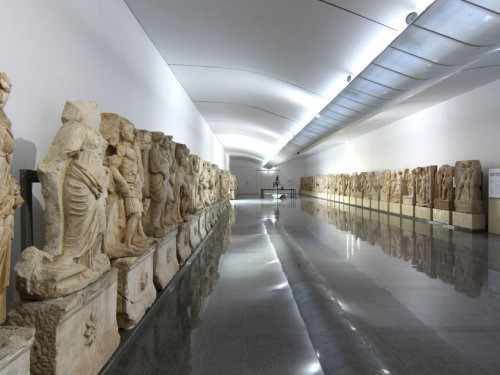
Sebasteion sculpture hall in the Museum (Daydreamtourist.com)
I have only scratched the surface of the many wonders of Aphrodisias. As I look back now at the photos of my recent visit I suddenly have a feeling of being homesick. Artemis, Aphrodite, Hekate, Apollo, Hermes and Zeus… all known in the Hellenistic world but their roots firmly embedded in the ancient world we now know as Anatolia. (Greek for EAST).
Underlying this ancient stream is the one goddess I have not mentioned in detail yet… KYBELE.
I will dedicate another article to her… “From Kybele to Cibeles”. For now the torchbearer continues the journey. 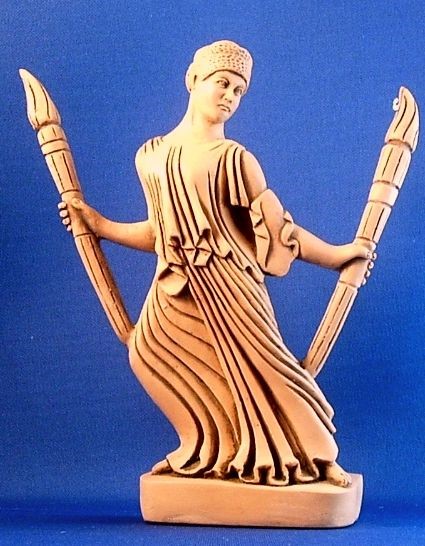
Hekate of the two torches
REFERENCES:
http://www.turizm.net/cities/aphrodisias/ 1, 2 , 3
http://www.nyu.edu/projects/aphrodisias/stad.htm
http://www.circewicca.nl/goden/kybele.html
http://www.istanbultours.org/aphrodisiasdaytrip.html
http://daydreamtourist.com/2012/07/25/you-must-see-aphrodisias/

